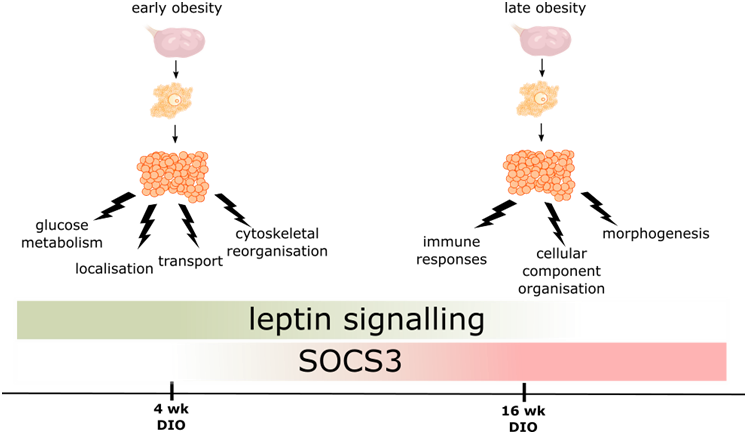
Figure. Main changes noted in the ovary of obese females.
The group led by dr. Antonio Galvao, Department of Team of Reproductive Pathology and Translational Medicine, have recently published the work entitled Leptin Resistance in the Ovary of Obese Mice is Associated with Profound Changes in the Transcriptome of Cumulus Cells, by Karolina Wołodko, Edyta Walewska, Marek Adamowski, Juan Casillo- Fernandez, Gavin Kelsey, Antonio Galvao in Cellular Physiology and Biochemistry (IF 5.5) (doi:10.33594/000000228) www.cellphysiolbiochem.com/Articles/000228. The study unravels the impact of altered leptin signalling on ovarian cells during obesity progression and uses the domestic mouse as a model for obesity and ovarian failure in woman (National Science Centre, project SONATA 8, 2014/15/D/NZ4/01152).
As one of the comorbidities of obesity, hormonal imbalance results from excessive leptin secretion during adipose tissue expansion. As a result, leptin resistance is established, a response previously reported in multiple organs in obese specimens, but not for the ovary. The present work describes temporal changes in leptin signalling in the course of obesity progression in mice, and indeed the establishment of leptin resistance in the ovaries of long term exposed mice to diet induced obesity. Furthermore, in collaboration with the group of dr. Gavin Kelsey, Babraham Institute, Cambridge, we sampled cumulus cells from the obese mice and identified global changes in transcription profile in as little as 50 cells.
Generally, our major findings show that during early stages of obesity, leptin signalling pathway in the ovary is activated, while on later stages leptin resistance develops. Furthermore, cumulus cells transcriptome is correlated with female body weight, as well as changes in the transcriptome during obesity progression were shown for the first time. Finally, we also show that during early obesity increase in leptin signalling affects expression of markers associated with intercellular macromolecule transport, cytoskeleton reorganisation and regulation of epigenetic processes. On the other hand, during late obesity there is an increase in expression of markers of inflammation and morphological changes. The present findings shed light on the molecular mechanisms leading to infertility in obese females and describe important markers of ovarian pathology during obesity progression.